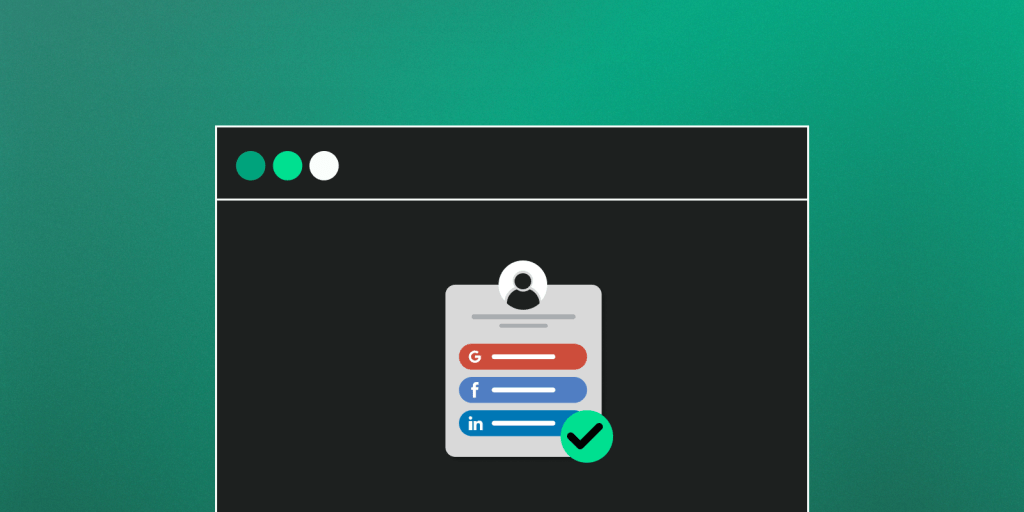We’ve all been there—facing a lengthy sign-up form and wondering if it’s worth the hassle. For many users, it’s not, so offering a quicker, more seamless option like social login can be a game-changer. With just a tap, users can sign in using accounts they already use, skipping the frustration and getting straight to what matters. It’s not just convenient for them—it’s also a smart move for businesses, opening the door to better data collection and higher conversion rates. So, how can you integrate social login and make onboarding effortless? Let’s break it down.

What Is Social Login and Why It Matters
Social login is a feature that lets users sign up or log in to a website using their credentials from popular platforms like Google, Facebook, or LinkedIn. This streamlined process offers several benefits:
– Ease of Use: Users can register with just a click, avoiding lengthy forms.
– Enhanced Security: Reduces password fatigue, lowering the risk of weak or reused passwords.
– Improved Conversion Rates: Simplifies the registration process, increasing sign-up rates.
– Rich Customer Data: Access verified data like email addresses, names, and even interests, depending on the provider’s permissions.
Key Considerations Before Integrating Social Login
Before implementing social login, addressing a few key factors is essential to ensure a smooth experience for both users and your business. Here’s what to keep in mind:
1. Understand Your Audience
Not all social networks appeal to every audience. For example, LinkedIn might be the top choice for B2B platforms, while Google or Facebook could be more suitable for consumer-facing businesses. Analyze your user base to determine which platforms will resonate most.
2. Comply with Data Privacy Regulations
Social login involves collecting user data, so following regulations like GDPR or CCPA is crucial. Be transparent about what data you’re accessing, explain why it’s needed, and ensure your privacy policy reflects this.
3. Offer Alternative Login Methods
Not every user will want to use social login, so providing other options, such as traditional email registration, is essential to avoid excluding anyone.
4. Evaluate Your Platform’s Compatibility
Check whether your website or app supports social login integration. If not, you may need to use plugins, third-party tools, or custom development to make it work seamlessly.
5. Prioritize Security
Social login reduces password fatigue, but it also introduces reliance on third-party providers. Implement secure authentication protocols like OAuth 2.0 and ensure all data exchanges happen over HTTPS to protect user information.
How to Implement Social Login
Integrating social login involves several steps, from selecting the right tools to ensuring seamless functionality. As a SAP Customer Data Cloud (SAP CDC) partner, we’ve seen firsthand how enterprise-grade solutions can elevate the process. Here’s how you can implement social login effectively:
1. Choose a Social Login Provider
Your choice of provider depends on your platform’s needs and your audience. Options include:
– OAuth Providers: Platforms like Facebook, Google, LinkedIn, and Twitter.
– Enterprise Solutions: SAP Customer Data Cloud (SAP CDC) offers robust tools for managing social login and identity data with advanced security and compliance features.
– Third-Party Tools: Services like Auth0 or Firebase Authentication can simplify implementation for smaller-scale needs.
2. Integrate SDKs or APIs
Implement SDKs or APIs provided by your chosen provider. With SAP CDC, you can leverage pre-built connectors and a streamlined interface for integrating social login across your website or app.
3. Design a User-Friendly Interface
Social login buttons should be intuitive and accessible. Use recognizable logos and colour schemes for each provider. SAP CDC also supports customizable interfaces, allowing you to align login options with your brand’s identity.
4. Test and Optimize
Before launching, thoroughly test the social login functionality across devices and browsers. SAP CDC’s tools can help monitor performance, troubleshoot errors, and ensure a seamless user experience.
5. Prioritize Data Security and Compliance
When collecting user data through social login, security and compliance are non-negotiable. SAP CDC offers enterprise-level security protocols and tools to ensure adherence to data privacy regulations like GDPR and CCPA.
Use Cases Across Industries
– E-Commerce: Simplify checkout processes by reducing barriers to account creation.
– Education Platforms: Enable students to sign in using Google or Microsoft credentials for single sign-on (SSO).
– SaaS Applications: Streamline enterprise onboarding by integrating LinkedIn login for business accounts.
– Gaming Apps: Allow gamers to connect via Twitch or Steam for a cohesive experience.
Challenges and How to Overcome Them
While social login simplifies customer onboarding, its implementation comes with challenges that, if not addressed, can impact user experience and business operations.
1. User Data Accuracy
– Challenge: Social accounts may contain outdated or incomplete information, such as inactive email addresses or misspelled names. This can affect communication and personalization efforts.
– Solution: Allow users to review and edit their profile information post-registration.
2. Account Duplication
Challenge: Users may forget which social account they used, leading to duplicate profiles and fragmented data.
– Solution: Offer account linking features that let users consolidate multiple login methods into a single account. By unifying customer data, SAP CDC’s identity management capabilities can help prevent duplicate entries.
3. Security and Privacy Concerns
– Challenge: Users might be hesitant to use social login due to data security and privacy risks.
– Solution: Build trust by clearly communicating what data is collected and how it’s used. SAP CDC’s robust compliance features, such as consent management and adherence to GDPR/CCPA, ensure user data is handled securely and transparently.
4. Limited Provider Options
– Challenge: Offering only one or two social login options may exclude users who don’t use those platforms.
– Solution: Analyze your audience to determine the most relevant social networks and provide at least two to three choices.
The Future of Social Login
Social login is evolving beyond traditional social networks. For now, integrating trusted social platforms remains the gold standard for reducing friction and enhancing user experience. Still, emerging trends in technology and user behaviour suggest exciting new possibilities for the future.
1. Decentralized Identity Systems
Blockchain-based solutions and decentralized identity (DID) systems are gaining traction. These systems allow users to manage their own digital identities without relying on centralized platforms. Unlike traditional social login, DIDs give users full control over their data, increasing transparency and security. For businesses, adopting solutions like these ensures greater trust while reducing dependency on specific providers.
2. Passwordless Authentication
Social login is a step toward a passwordless future, but new methods such as biometrics, email magic links, and mobile-based authentication are emerging. These options reduce friction even further and enhance security, offering alternatives for users who prefer not to link their social accounts.
3. AI-Powered Personalization
Data gathered from social login will increasingly be used to drive AI-powered personalization. With advanced tools like SAP Customer Data Cloud (SAP CDC), businesses can process this data in real time to deliver hyper-customized experiences, from tailored product recommendations to dynamic user interfaces.
4. Cross-Platform Access
The future of social login will emphasize interoperability, enabling seamless transitions between devices, platforms, and ecosystems. For example, a single login could grant access across apps, websites, and even smart devices, creating a unified and cohesive user experience.
Looking Ahead
The future of social login lies in balancing convenience, security, and user autonomy. Businesses that embrace these advancements will stay ahead of the curve and build deeper trust and loyalty with their customers. Social login, as we know it, is just the beginning.
At Trew Knowledge, we leverage advanced technologies to transform customer experiences and fulfill business ambitions. Whether it’s streamlining your onboarding process, upgrading your data security, or setting up advanced identity management frameworks, our team provides comprehensive support every step of the way. Let’s connect and make it happen!

